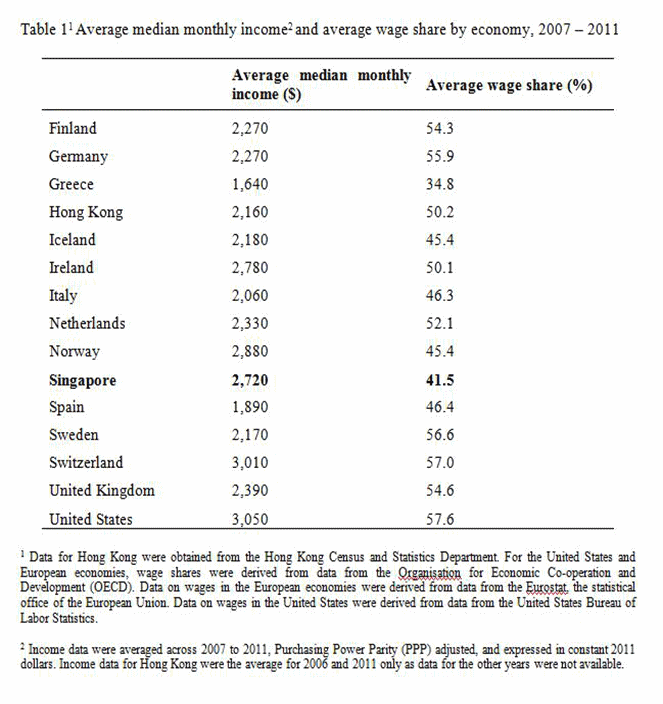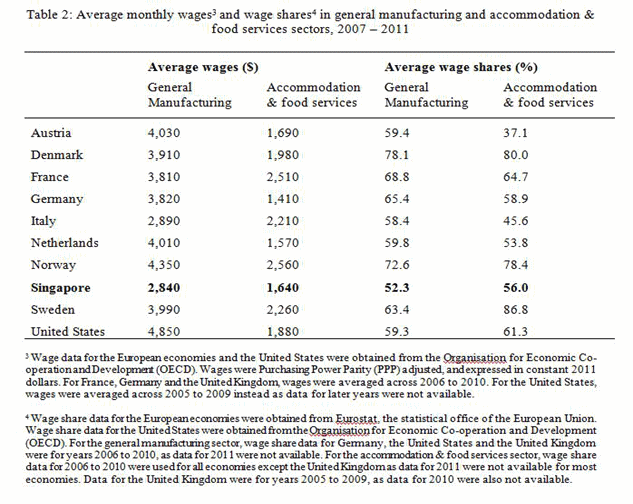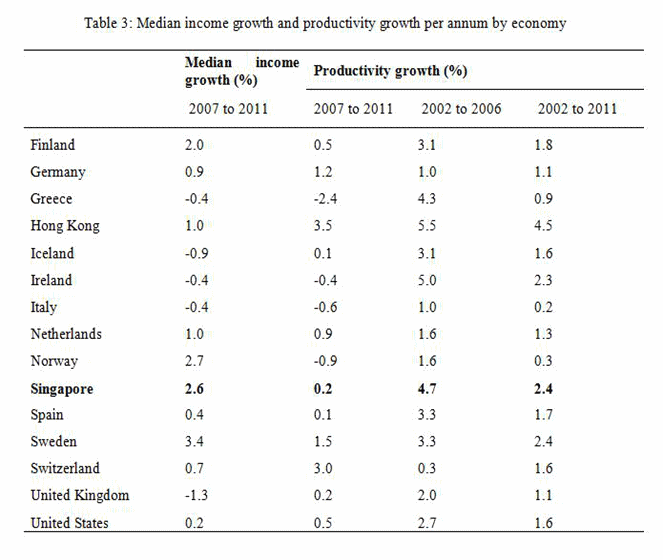Mr Gerald Giam Yean Song asked the Minister for Trade and Industry (a) how does Singapore compare with developed economies in terms of median monthly wages and wage shares; (b) how do the biomedical sector, general manufacturing sector, and the accommodation and food services sector in Singapore compare with their counterpart sectors in developed economies in terms of sectoral average monthly wages and sectoral wage shares; and (c) how does Singapore compare with developed economies in terms of productivity growth and median wage growth.
In January 2013, during my Parliamentary speech on the debate on the Population White Paper, I had said:
The generous supply of foreign workers has lowered the bargaining power of local workers, forcing them to accept lower wages in order to be competitive. This has led to much of the benefits of our stellar GDP growth accruing to company profits instead of workers’ wages. Our workers’ wage share as a percentage of GDP is relatively small compared with most other developed countries. In 2011, just 42.3% of Singapore’s GDP went to workers’ wages (SingStat 2012, 9). In contrast, according to OECD data, the wage share is 47.5% in Australia, 49.2% in the European Union and 52.3% in Canada (OECD 2011).
On 23 May 2013, the Ministry of Trade and Industry (MTI) published an article “A Look at Wage Share and Wages in Singapore” in their Economic Survey of Singapore (First Quarter 2013).
The MTI article wrote:
Some argue that this shows that workers in Singapore are underpaid, and that Singapore’s economic growth has disproportionately benefitted multinational companies and capital owners at the expense of workers. This article…finds that higher wage shares do not necessarily translate to higher wages.
The Straits Times did a report on this MTI article (“Lower wage share doesn’t mean wages are lower: Salaries are correlated with productivity, says MTI”, Straits Times, 24 May 2013), stating:
Over the years, this trend has led economic watchers as well as the Workers’ Party to argue that Singapore’s workers are underpaid and that economic growth has benefited companies at the expense of workers.
During the 8 July 2013 sitting of Parliament, I asked the Minister for Trade and Industry for more information regarding median wages in different industrial sectors in Singapore and their wage shares vis-a-vis those in developed economies. This was my question and the answer I received.
—————–
Mr Gerald Giam Yean Song asked the Minister for Trade and Industry (a) how does Singapore compare with developed economies in terms of median monthly wages and wage shares; (b) how do the biomedical sector, general manufacturing sector, and the accommodation and food services sector in Singapore compare with their counterpart sectors in developed economies in terms of sectoral average monthly wages and sectoral wage shares; and (c) how does Singapore compare with developed economies in terms of productivity growth and median wage growth.
Mr Lim Hng Kiang (Minister for Trade and Industry): Between 2007 and 2011, Singapore’s wage share of GDP averaged at 41.5 per cent. This was lower than the wage shares of many developed economies, which were typically at 50 per cent or more (see Table 1 below).
Over the same period, the PPP-adjusted real median gross monthly income of full-time employed residents in Singapore was $2,7204, higher than the median income of workers in developed economies such as Germany and the United Kingdom, but lower than that of workers in economies like the United States.
Between 2007 and 2011, the PPP-adjusted real average monthly wages of workers in Singapore in the biomedical cluster, general manufacturing cluster and the accommodation & food services sector were $4,880, $2,840 and $1,640 respectively (see Table 2 below)5. The corresponding wage shares were 6.8 per cent, 52.3 per cent and 56.0 per cent respectively.
While the average wage and wage share in Singapore’s general manufacturing cluster tended to be lower than those of developed economies, our average wage and wage share in the accommodation & food services sectors were comparable with those of other economies. A similar comparison for the biomedical cluster could not be made as comparable wage and wage share data for this cluster were not available for the other economies.
Singapore’s labour productivity growth from 2007 to 2011 was 0.2 per cent per annum, slower than that in many developed economies such as the United States, Germany and Hong Kong, but comparable with the United Kingdom, Italy and Spain (see Table 3 in the Appendix). Productivity can be affected by economic cycles, and should be viewed over a longer period of time. Our labour productivity growth from 2002 to 2011 was 2.4 per cent per annum. This outpaced the labour productivity growth in developed economies such as the United Kingdom, Germany, and the United States.
The growth in the real median gross monthly income of full-time employed resident workers in Singapore was 2.6 per cent per annum over the period of 2007 to 20116. This was faster than the real median income growth for workers in developed economies such as the United Kingdom, the United States, Germany, and Hong Kong.



4 Income data were averaged across 2007 to 2011, Purchasing Power Parity (PPP) adjusted, and expressed in constant 2011 dollars.
5 Wage data were averaged across 2007 to 2011, Purchasing Power Parity (PPP) adjusted, and expressed in constant 2011 dollars.
6 For the ten-year period ending 2011, real median gross monthly income of full-time employed resident workers in Singapore grew by 1.3 per cent per annum. However, comparable data for other economies were not available before 2005. We hence made comparisons for the growth from 2007 to 2012.
——————-
Source: Singapore Parliament Reports (Hansard)



